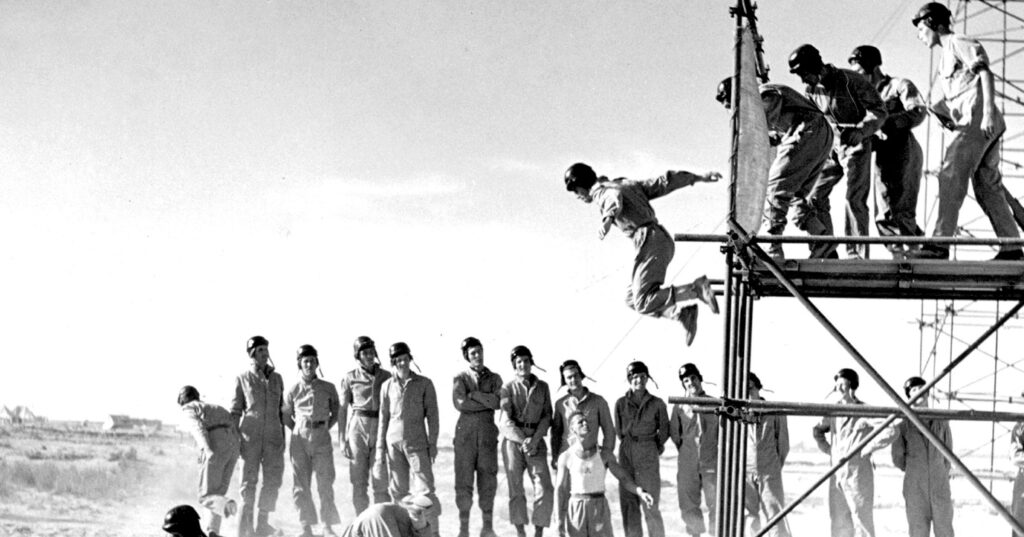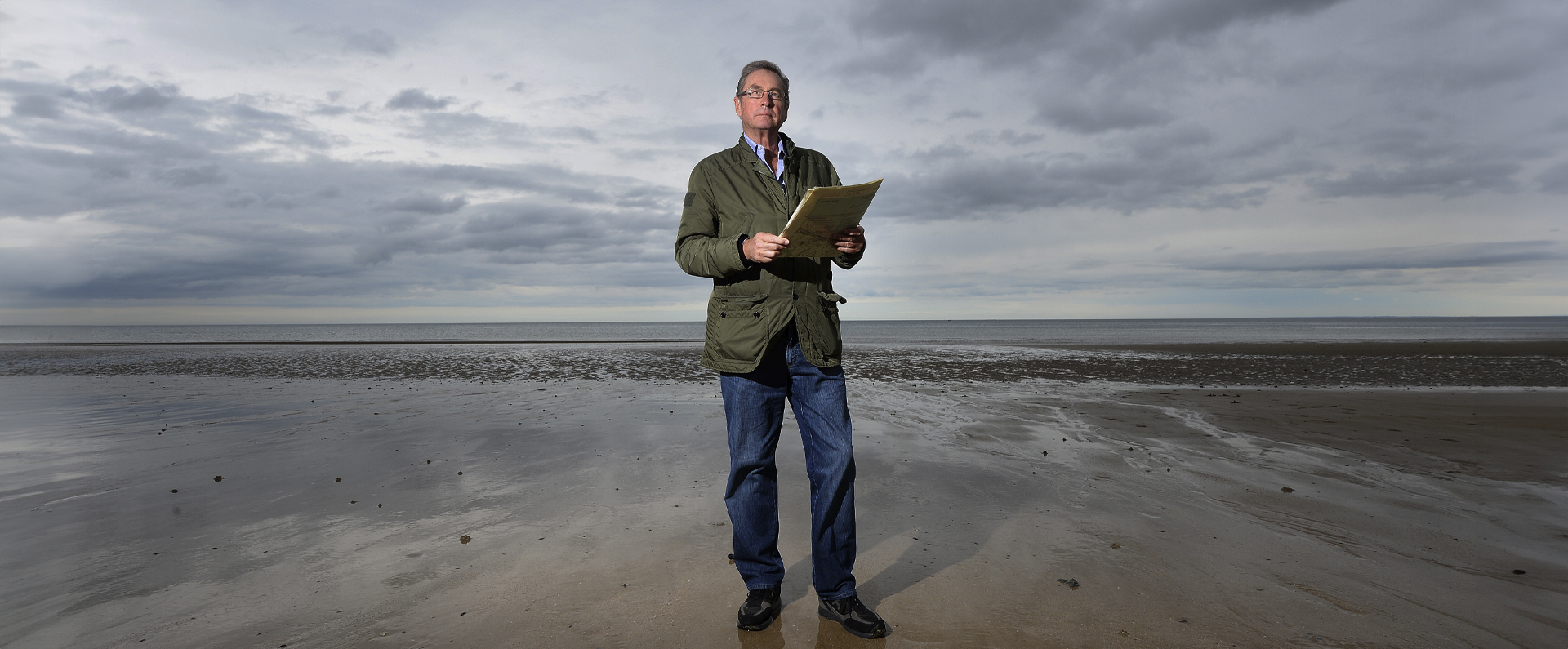
Published in Britain at War in July 2021.
Sergeant John Vincent Byrne DCM
By any standards, Sergeant John ‘Jack’ Byrne had a quite remarkable war: being left for dead at the time of the Dunkirk evacuation, being a founding father of the SAS in the deserts of north Africa, being captured, shot and beaten, and escaping from a German prisoner-of-war (PoW) camp in time to serve as a Commando on D-Day.
When Christopher Hill, of auctioneers DNW (Dix Noonan Webb), was preparing Byrne’s medals for sale, he said: “If I could have only one Second World War medal group, I would be hard pressed to come up with a better one than this. One could not wish for a more representative medal group to capture the iconic image of your Second World War Commando hero than this man.” At the subsequent auction, I became the proud custodian of this incredible man’s medal group.
John Vincent Byrne was born on April 1 1921 in Preston, Lancashire. He enlisted into the 1st Battalion, Gordon Highlanders, in February 1939, aged seventeen. Byrne saw action with the British Expeditionary Force (BEF) in France, where he was twice wounded, first by shrapnel and then, in desperate hand-to-hand combat, by a deep bayonet thrust just above his groin.
His latter injury took place during the 51st Highland Division’s rearguard action on the Dunkirk perimeter. Byrne was left for dead at the bottom of a trench but was found, semi-conscious, by two French civilians who carried him to the beachhead, where he was evacuated to England.
After making a quick recovery from his injuries, Byrne became a founding member of ‘L’ Detachment, SAS. In his wartime memoir, published in 1986, Byrne explained how this came about: “When France fell in 1940, I transferred to 11 (Scottish) Commando and served with them until the unit was disbanded after storming the beaches north of the Litani River during the invasion of Syria. By this time 7 Commando and 8 (Guards) Commando, their ranks depleted by the fighting in Crete and Tobruk, had also been disbanded. It was from these remnants of the Middle East Commandos that Captain David Stirling selected the original members of ‘L’ Detachment, the 1st Special Air Service Brigade, myself among them, which he founded in July 1941. Later the unit became the 1st SAS Regiment.’
After completing his parachute training, Byrne took part in ‘L’ Detachment’s first operational jump on the night of November 16 1941. Their aim was to destroy enemy aircraft on five airfields between Timimi (sometimes also spelt ‘Timini’) and Gazala on the eve of ‘Operation Crusader’, the British offensive to relieve Tobruk.
However, conditions on the night chosen for the mission were entirely unsuitable: there was no moon and high winds whipped up clouds of dust, which made accurate navigation impossible. None of the parachutists landed within ten miles of the pre-arranged drop zones, and weapons and other vital equipment needed for their mission also went astray. Only four officers and eighteen other ranks, out of a total of fifty-three men, returned to the safety of British lines.
A month later, however, Byrne was involved in a much more successful mission, this time a raid on Agedabia airfield when five men successfully destroyed 37 enemy aircraft. ‘L’ Detachment’s surprise attack took place when it was based at the oasis of Jalo in the Western Desert. In his memoirs, Byrne vividly describes what happened after they were dropped some fifteen miles south of their target before making their way to the airfield.
‘Stepping over the fence, I strode onto the airfield, the others following. Moving swiftly, we soon reached the runway, on the other side of which was the first batch of aircraft, a mixed bag of fighters and bombers of all types. Losing no time, we set to work placing our bombs high up on the wings of the bombers and on the noses of the fighters…
‘The aircraft were parked close together in clusters, each group about 200 yards apart. Keeping together, we dealt with every plane in each batch before moving on to the next. During all this time we saw no sign of any enemy personnel. When it was thought there were no more planes, Bill Fraser and Bob Tait put bombs on a tractor and a covered lorry which were parked together in the centre of the runway. Punctually, the first of our time-bombs exploded and the aircraft burst into flames. Other bombs followed, exploding in quick succession until the centre of the airfield was one great forest of fires. Then, as enemy machine-guns began firing tracer bullets on fixed lines down two sides of the airfield and partly across our escape route, searchlights probed the sky, mistakenly believing the RAF were overhead. Their anti-aircraft guns too soon joined in sending up great sheets of exploding flak. There was the most tremendous din, with ammunition crackling in the exploding and burning aircraft, the continuous rattle of machine guns and, noisiest of all, the rapid-firing flak-guns. The enemy, convinced that they were being attacked by bombers of the Royal Air Force, made no attempt to save their aircraft and wisely remained in their bunkers and foxholes, for not one aimed shot came our way.”
Many other missions followed: some successful, others less so. After one missed rendezvous with the Long Range Desert Group (LRDG), Byrne and four others had to embark on a 200-mile desert trek before hijacking a German staff car. In March 1942, another desert mission – an attack on Berka airfield – went wrong when bombs the men had planted went off early. Having missed his rendezvous, Byrne struck out alone, but on the fifth day, and desperately short of water, he was captured by an enemy patrol just 70 miles from Allied lines. A German officer emerged from the turret of a tank and ran towards him.
Byrne later wrote: “He stopped about three feet away, breathing heavily, his pistol held in front of him within inches of my face. As I yanked my revolver from its holster and flung it on the ground, the German, either nervous or sensing defiance, drew back his pistol to strike at me, then fired point-blank into my face. I fell, half stunned, face down in the sand, blood spurting from nose and temple.”
In fact, the bullet had only brushed his face and, after some medical assistance from the Germans, Byrne was able to prepare for the ordeal ahead: he was savagely beaten by an Italian officer and guards when they discovered he had been concealing his fighting knife following his capture. Further brutal beatings followed.
Flown to Athens, Byrne was taken by rail to Dulag Luft, the Allied aircrew interrogation centre near Frankfurt, from whence he was sent to the NCOs’ compound at Stalag Luft III at Sagan and, later, to other PoW camps. In October 1942 and March 1943, he made two unsuccessful escape attempts, receiving 24 days in the ‘cooler’ for the second one.
On July 16 1943, Byrne and five RAF aircrew spent the night at a transit camp at Konigsberg while en route to Stalag Luft VI at Heidekrug. Next morning, he lowered himself into a latrine drain and passed into a neighbouring Russian compound from which he escaped by breaking through a rusty fence with his bare hands, the whole procedure taking about five minutes. That night he made his way to Konigsberg docks and fell in with some French forced labourers, who supplied him with a suit of blue overalls, food, money and advice.
Byrne stole a bicycle on the 19th and, two days later, arrived in Danzig (then in Germany but now in Poland) at dawn, having spent the intervening nights up a tree and in an old signal box. With help from another Frenchman he reached the docks and, mingling with a working party, slipped past a German guard and boarded a Swedish ship. Byrne hid in the bowels of the ship for the next two days until at last it began to move. A few hours later he revealed himself to the crew and demanded an interview with the captain, who duly congratulated him on his escape. Byrne eventually returned to the UK in an unarmed Mosquito aircraft on August 14 1943.
It was for his escape that Byrne was awarded the Distinguished Conduct Medal (DCM) on October 7 1943 after his once-confidential recommendation ended: “This N.C.O. showed courage, pertinacity and initiative of the very highest order under the most trying circumstances.”
A period of recuperation and re-training followed before Byrne was posted, with the rank of lance sergeant, to 6 Commando, part of Lord Lovat’s 1st Special Service Brigade. In September 1943 he was chosen to take part in a promotion of National Savings certificates with General Sir Frederick Pile, the commander of the City of London. On one occasion, Pile saluted him in front of a large crowd, thereby giving him the name of his wartime memoir, The General Salutes a Soldier.
On June 6 1944, having been in a sealed camp with 6 Commando since the previous month, Byrne took part in the D-Day invasion, landing on Queen section of Sword Beach (incidentally where my father, Lieutenant Eric Ashcroft, landed on D-Day with the South Lancashire Regiment). Along with his fellow Commandos, Byrne was tasked with infiltrating through enemy defensive positions in the landing area and linking up with the 6th Airborne Division, which was being dropped in darkness to secure bridges over a river and canal. He advanced to the beach and then to a partly demolished building with two comrades, one of whom was shot dead.
As Byrne and his comrades advanced inland over the next day or two, he was shot in the knee, a serious wound that resulted in him spending six months in hospital. However, he recovered in time to join the re-forming brigade and go with them to north-west Europe. Byrne was involved in the heavy fighting to take Maasbracht, Holland. Later, after being promoted to sergeant, he was involved with 1st Commando Brigade, as it was then called, in fierce close-quarter fighting after crossing the Rhine and advancing to capture Wessel. His last front-line action came on April 29 1945 when he was involved in capturing a vital bridge over the Elbe Trave Canal.
After serving with the 4th Norfolks in Greece and the 2nd Royal Fusiliers in Egypt, Byrne was demobbed in February 1947, when he joined the Kenya Police. Following the Malaya Emergency in 1948, he answered the call for volunteers and was posted to the Kulai Police District in Johore on internal security duties. In 1953, he was shot in the stomach at pointblank range and received injuries that ended his service. After being discharged from hospital, he returned to Kenya to work in the prison service.
He married in 1955 and he and his wife, Mary Hayes, went on to have three daughters. He retired from the prison service in Kenya in 1958 before settling in Shropshire, where he built up a drapery business that he ran until his retirement in 1986. Byrne died on January 10 2007, aged eighty-five.
Download a PDF of the original Britain at War article
For more information, visit:
LordAshcroftOnBravery.com


